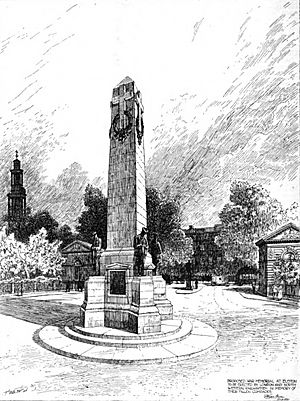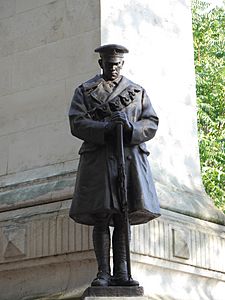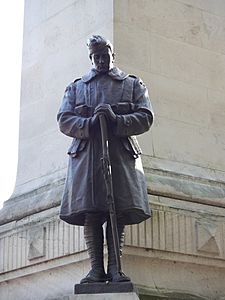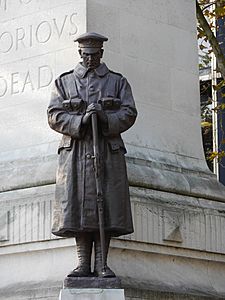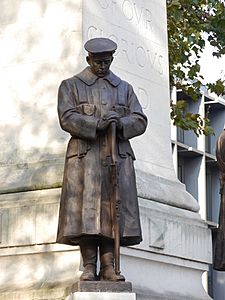London and North Western Railway War Memorial facts for kids
Quick facts for kids London and North Western Railway War Memorial |
|
|---|---|
| United Kingdom | |
 |
|
| For employees of the London and North Western Railway killed in the First World War | |
| Unveiled | 21 October 1921 |
| Location | 51°31′38.1″N 0°07′57.2″W / 51.527250°N 0.132556°W Euston railway station, London
|
| Designed by | Reginald Wynn Owen |
|
IN MEMORY OF OUR GLORIOUS DEAD
|
|
|
Listed Building – Grade II
|
|
| Designated | 11 January 1999 |
| Reference no. | 1342044 |
The London and North Western Railway War Memorial is a special monument in London, England. It stands outside Euston railway station. This memorial remembers the many employees of the London and North Western Railway (LNWR) who died in the First World War.
The memorial was designed by Reginald Wynn Owen. He was the main architect for the LNWR company. More than 37,000 LNWR workers, about a third of their staff, joined the war effort. The company also used its resources to help.
Building the memorial cost about £12,500. The employees themselves gave £4,000, and the company paid the rest. The monument is a tall stone pillar, called an obelisk, standing 13 meters (about 43 feet) high. It has a cross and a bronze wreath at the top. At its base, there are four large statues of soldiers and sailors. These statues show an artilleryman, an infantryman, a sailor, and an airman. It was quite special to include an airman so clearly at that time.
The memorial was officially revealed on 21 October 1921. A very important general, Douglas Haig, 1st Earl Haig, led the ceremony. Many people attended, especially LNWR workers and their families. Today, this memorial and two small buildings are all that remain of the old Euston station. The memorial is a protected historical site, known as a grade II* listed building.
Why This Memorial Was Built
The London and North Western Railway (LNWR) was a very big railway company in Britain. After the First World War, many memorials were built. Companies like the LNWR wanted to remember their workers who died.
Many railway workers were in jobs that meant they didn't have to join the army. But even before joining the army became compulsory, over 4,000 LNWR employees volunteered. By the end of the war, 37,742 men from the railway had gone to fight. Sadly, 3,719 of them were killed.
Three LNWR employees received the Victoria Cross. This is the highest award for bravery in the British military. Their names were Lance Corporal John Alexander Christie, Private Ernest Sykes, and Private Wilfred Wood. The LNWR even named a train after each of these heroes.
The LNWR was one of the biggest companies in Britain. During the war, its main engineering factory, Crewe Works, helped a lot. Skilled workers there made artillery shells and other military supplies. They also built trains to move soldiers and equipment.
The memorial cost about £12,500. LNWR staff donated about £4,000, and the company paid the rest. The company's architect, Reginald Wynn Owen, designed it. A company called R. L. Boulton & Sons built it.
What the Memorial Looks Like
The memorial is a tall, single stone pillar called an obelisk. It is 13 meters (about 43 feet) high and made of Portland stone. It stands on a tall base and a round granite platform. Near the top of the obelisk, on each side, there is a bronze wreath and a stone cross.
The front of the obelisk has a simple message: "IN MEMORY OF OUR GLORIOUS DEAD". A granite plaque in front of the memorial has a longer message. It says:
In grateful memory of 3719 men of the London and North-Western Railway Company who for their country, justice and freedom served and died in the Great War 1914–1919. This monument was raised by their comrades and the company as a lasting memorial to their devotion.
Later, more plaques were added. These remember the men and women of the London Midland and Scottish Railway who died in the Second World War.
Around the base of the memorial are four large bronze statues. These statues show different military figures. They are an infantryman, an artilleryman, a sailor, and an airman. Each statue stands with its head bowed, holding a rifle upside down. It was quite unusual for a First World War memorial to show an airman so clearly. Ambrose Neale, a main artist at Boulton & Sons, created these figures.
The architect, Wynn Owen, said the crosses on the obelisk showed the Christian beliefs of those who fought. He wanted the memorial to be simple and grand. He also said it was to honor the dead, not to celebrate victory.
- The four bronze statues by Ambrose Neale
History of the Memorial
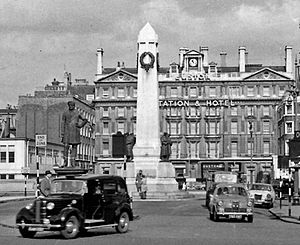
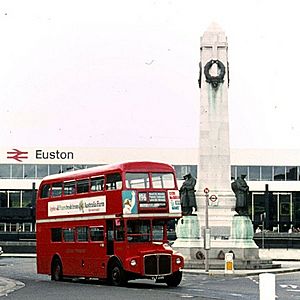
The LNWR memorial was officially unveiled on 21 October 1921. Douglas Haig, 1st Earl Haig, who commanded British forces in the war, led the ceremony. He praised the LNWR's help in the war. The Archbishop of Canterbury, Randall Davidson, also spoke.
Ernest Sykes, one of the Victoria Cross heroes, was there. The LNWR chairman, Charles Lawrence, also spoke. The other two Victoria Cross recipients, Christie and Wood, were present too.
Over 8,000 people came to the ceremony. The company even arranged special trains to bring employees and their families from other cities. Ernest Sykes laid the first wreath at the memorial's base. Other employees who had received military awards stood in a special formation.
At the ceremony, speakers focused on duty and patriotism. They encouraged workers to follow the brave example of those who died. Haig spoke of the "burden these men bore so bravely". Lawrence told the crowd:
We, the survivors, should dedicate ourselves anew to the service of our country, and that, especially in our character of employers and employees, we should strive to act in a spirit of mutual sympathy, of mutual forbearance, of absolute rectitude of purpose, and even of magnanimity if we wish to assist in the binding up of the wounds of our common country, and so prove ourselves worthy of the sacrifice these men have made for us.
The company also created a "Roll of Honour." This book listed all 3,719 dead employees. It included their railway job, military rank, and any awards. A copy was given to the closest family member of each person who died.
The memorial was originally in the middle of Euston Square. It was in line with the Euston Arch, a grand entrance to the old station. In the 1960s, the area was rebuilt. The old station building and the arch were taken down. A new, modern station was built. In the 1970s, a new office building was put in front of the memorial. This building now blocks the view of the memorial from the station entrance.
The memorial is a grade II* listed building. This means it is a very important historical building and is protected. This status helps prevent it from being changed or removed. The listing document calls it "an eloquent witness to the tragic impact of world events." It also notes its importance with the two station lodges nearby. These lodges and the memorial were the only parts of the old station to survive the 1960s rebuilding. Network Rail is responsible for maintaining the memorial today.


